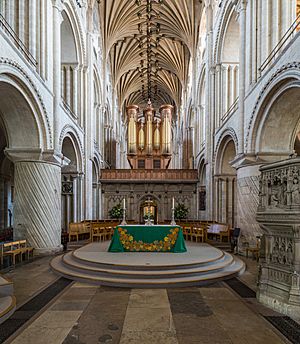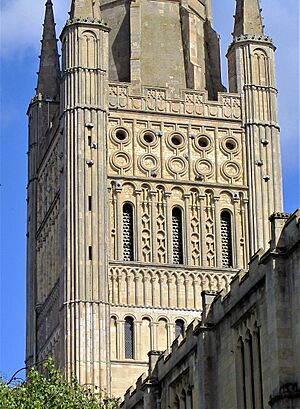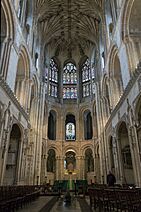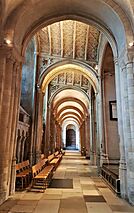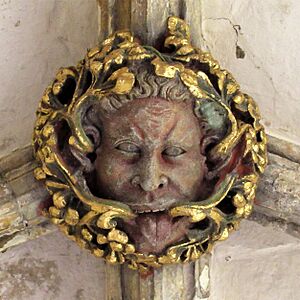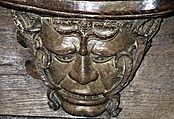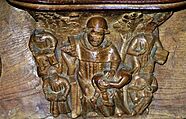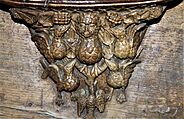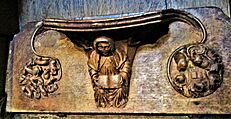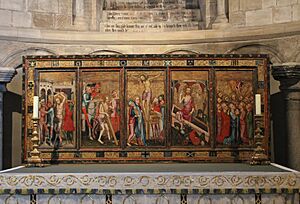Norwich Cathedral facts for kids
Quick facts for kids Norwich Cathedral |
|
|---|---|
| Cathedral Church of the Holy and Undivided Trinity | |
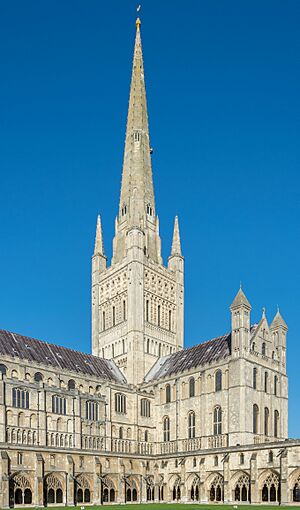
|
|
| Location | Norwich, Norfolk |
| Country | England |
| Denomination | Church of England |
| Previous denomination | Roman Catholic |
| History | |
| Authorising papal bull | 300945 |
| Consecrated | 24 September 1101 (reconsecrated 1278) |
| Architecture | |
| Style | Norman, Gothic |
| Years built | 1096–(1121–1145) |
| Specifications | |
| Length | 124 m (407 ft) |
| Nave length | 76.8 m (252 ft) |
| Width | 54.9 m (180 ft) |
| Nave width | 21.9 m (72 ft) |
| Nave height | 21.9 m (72 ft) |
| Spire height | 96 m (315 ft) |
| Bells | 5 (formerly 10) |
| Administration | |
| Diocese | Norwich (since 1094) |
| Province | Canterbury |
Norwich Cathedral, also known as the Cathedral Church of the Holy and Undivided Trinity, is a very old and important church in Norwich, England. It is the main church for the bishop of Norwich and is part of the Church of England. Services are held there every day. It is a Grade I listed building, which means it's a very special historic building.
Building the cathedral started in 1096. It was ordered by the first bishop of Norwich, Herbert de Losinga. When the main tower was finished, the cathedral became the largest building in East Anglia. It was 461 ft (141 m) long and 177 ft (54 m) wide. The area around the cathedral, called the cathedral close, was a huge part of the medieval city.
Norwich Cathedral is mostly built in the Norman style. It is made of flint and mortar, covered with cream-coloured Caen limestone. The cathedral was damaged in riots in 1272, but repairs were finished by 1278. Its cloisters, which are covered walkways, were started in 1297 and are the second largest in England. The current spire is made of stone and was built in 1480. It is the second tallest in England at 315 ft (96 m). In 2010, Elizabeth II and the Duke of Edinburgh opened a new building for visitors and education.
Norwich Cathedral once had the earliest astronomical clock in England. The carved decorations on its ceilings, called bosses, are amazing medieval artworks. They survived through times when many religious artworks were destroyed.
Contents
History of Norwich Cathedral
Early Beginnings
In 672, the Archbishop of Canterbury divided the area of East Anglia into two church regions. One was in Norfolk and the other in Suffolk. For a long time in the 800s, there was no bishop in Norfolk because of Viking attacks. After the Normans took over England, church leaders moved their main churches to safer cities. So, the church in Norfolk moved to Thetford in 1072, and then to Norwich in 1094. The new cathedral was named after the Holy and Undivided Trinity. Like other Norman cathedrals, it also had a monastery for Benedictine monks.
Norman Construction
The cathedral's main structure is in the Norman style. It was built because the first bishop of Norwich, Herbert de Losinga, wanted it. He had bought the bishopric for £1,900. To make space for the cathedral, an Anglo-Saxon village and two churches were taken down. A canal was dug so boats could bring stone and building materials up the River Wensum.
Medieval Changes
The cathedral was damaged during riots in 1272. The city had to pay large fines to King Henry III. The cathedral was blessed again in 1278, with King Edward I present.
In 1362, the original Norman spire was blown down by a storm. This damaged the east end of the building. In 1463, lightning struck the spire, causing a big fire in the main part of the church, called the nave. The fire was so hot that some of the cream-coloured stone turned pink! In 1480, Bishop James Goldwell ordered a new stone spire to be built, which is the one you see today.
Challenges in the 1600s
During the English Civil War in 1643, a group of Puritans attacked the cathedral. They destroyed many Roman Catholic symbols inside. The building was left empty the next year and stayed in ruins for 20 years. The attackers even fired their muskets, and you can still see musket balls stuck in the stone walls. The cathedral was finally repaired when the king returned to power in 1660.
Recent Updates
In the 1830s, the south part of the church, called the transept, was redesigned by architect Anthony Salvin. From 1930 to 1932, a new Lady Chapel was built at the east end. This chapel was designed by Charles Nicholson.
Norwich Cathedral is one of the "Norwich 12", a list of the city's most famous buildings. This list was created in 2008 to highlight important heritage sites.
Modern Additions
In 2004, a new dining hall, called a refectory, opened. It was built where the old one used to be, next to the cloisters. Work on a new entrance building, called the hostry, began in 2007. This project cost £10 million. Queen Elizabeth II and the Duke of Edinburgh opened it on May 4, 2010. The new hostry is now the main way to enter the cathedral and has space for art exhibitions.
Helter-skelter Fun
In July 2019, a 17 m (56 ft) tall helter-skelter slide was put inside the cathedral! It was meant to attract more visitors and let people see the amazing carved ceiling bosses up close. Some people loved the idea, while others, like a former chaplain to the Queen, thought it was not right for a church. In August 2019, the Bishop of Lynn even sang a song while sliding down!
Architecture of Norwich Cathedral
Building Styles and Dates
Building the cathedral started from the east end in 1096. The main part of the church, the nave, was finished around 1120. The whole cathedral was completed by 1145 when the central tower was built. It was made from flint and mortar, with cream-coloured Caen limestone on the outside.
The current stone spire was added in 1480. It replaced an earlier wooden one covered in lead.
After the riots in 1272, repairs were finished in 1278. Some of the windows were replaced with new ones in the Gothic style during the 1200s.
The cloisters began in 1297 and were finally finished in 1430. This was after the Black Death had affected the city. Even though it took a long time, the building style stayed similar.
After the spire fell, the upper part of the choir walls, called the clerestory, was rebuilt in the Perpendicular style.
In the 1400s, the cathedral's flat wooden ceilings were replaced with stone vaults. The nave ceiling was vaulted under Bishop Walter Hart (1446–1472). The choir and a chapel were vaulted under Bishop James Goldwell (1472–1499). The transepts were vaulted after 1520. These stone ceilings are amazing, with hundreds of beautifully carved, painted, and gilded bosses decorating them.
Cathedral Layout
When it was finished, Norwich Cathedral was the largest building in East Anglia. It was 461 ft (141 m) long and 177 ft (54 m) wide. The layout of the cathedral is almost exactly as it was in Norman times. The main part of the church, the nave, is unusually long with 14 sections. The transepts (the arms of the cross shape) do not have side walkways. The east end finishes in a rounded shape called an apse with a walkway around it. From this walkway, you can reach two chapels that have an unusual shape, based on two circles joining together.
Outside Features
The tower is one of the most impressive Norman towers still standing in England. It is decorated with geometrical circles, diamond shapes, and criss-crossing arches.
The spire is made of brick covered with stone. At 315 ft (96 m) high, it is the second tallest in England. Only Salisbury Cathedral's spire is taller, at 404 ft (123 m).
Norwich Cathedral has the second largest cloisters in England, only smaller than Salisbury Cathedral's. It has two levels, which is unique in England, and nearly 400 carved stone ceiling bosses.
Inside the Cathedral
The east end of the cathedral, near the altar, is shaped like an apse. The vaulted area inside the apse is very tall and has large pillars with big capitals (the tops of the pillars).
Norwich Cathedral no longer has its rood screen, which was a large screen that used to hold a big crucifix. It was located in front of the pulpitum (a screen separating the nave from the choir). The side walkways are vaulted in stone, but they don't have ribs.
Norwich, Salisbury, and Ely are the only Anglican cathedrals that do not have a ring of bells. The astronomical clock at Norwich Cathedral was one of the earliest mechanical clocks made in England.
Art and Treasures
Stained Glass Windows
Most of the medieval stained glass windows in the cathedral were destroyed during the English Reformation. They were damaged even more during the English Civil War.
The glass in the large west window was designed by George Hedgeland and put in place in 1854.
Ceiling Bosses
The bosses of Norwich Cathedral are some of the most important medieval sculptures in the world. It's amazing that they survived the destruction of religious art during the Tudor times and the English Civil War. A church historian named Charles John Philip Cave said they are "undoubtedly the most important series in the country."
There are over 1,000 bosses. The earliest ones show natural things like flowers and leaves. Later ones show people, mythical animals, hunting scenes, or single stories from the lives of saints. Some bosses even tell a story in a sequence, like the history of the world from creation in the nave ceiling. The bosses are easiest to see in the cloisters because they are lower. The east part of the cloister has many plants and scenes from the Passion of Jesus. The north part shows the Resurrection and scenes of Mary, mother of Jesus and saints. The south and west parts show the Apocalypse, as well as the Annunciation and Herod's Feast.
Misericords
During the Middle Ages, monks would gather eight times a day for church services. They stood for most of these services. Over time, some monasteries added seats with small ledges called 'misericords'. These ledges allowed monks to lean and rest a little, which was literally an "act of mercy." Most misericords have a main carving and two smaller carvings on either side.
Norwich Cathedral likely had 70 choir-stalls originally, for the bishop, his senior clerics, and 60 monks. Today, 64 choir-stalls remain. All but four of these have misericords from the early 1400s. It's thought that the more important clergy might have chosen the carvings for their own misericords. The armrests were also beautifully carved. Many of the smaller carvings on Norwich's misericords are related to the main subject. For example, the misericord for Bishop Richard Courtenay shows a seated monk with smaller carvings of a bishop looking after sheep and the bishop as Chancellor of Oxford. The fire of 1463 damaged many stalls, and new misericords were made for the replacements.
The misericords at Norwich Cathedral can be grouped by their designs. Some, called Wakering's, have curved and ribbed ledges with battlement patterns. They are carved with the coats of arms of the people who helped pay for rebuilding the choir. The Goldwell misericords have rounder ledges. The two Nykke misericords have special carved seat edges. The subjects chosen for the carvings seem random. They include many real and legendary animals, daily tasks, events, people (both real and imaginary), pictures of the seven deadly sins, and stories (mostly not from the Bible).
Despenser Reredos
In St Luke's Chapel, behind the altar, there is a late 14th-century altarpiece called the Despenser Retable or Despenser Reredos. It is named after the Bishop of Norwich, Henry le Despenser (1369–1406). During the Peasants' Revolt of 1381, Despenser's forces successfully stopped the revolt in Norfolk. The altarpiece might have been made to give thanks for this victory. The shields around the edge of the painting belong to others who helped defend against the peasants. The reredos was found in 1847, damaged, after being used as part of a table.
Other Interesting Features
The copper baptismal font in the nave is on a movable base. It was made from bowls that were used to make chocolate at the Rowntree's factory in Norwich. It was given to the cathedral after the factory closed in 1994.
Since 2013, a survey has found a lot of medieval graffiti carved into the stone walls inside the cathedral. This includes organ music written on musical staves.
Music at Norwich Cathedral
Organ and Organists
Norwich Cathedral's organ is one of the biggest in the UK. It was built by a local company, Norman and Beard, in 1899. It was later damaged in a fire in 1938. In 1969, a Cymbelstern with six bells and a spinning star was added to the organ. In 2017, the cathedral planned to spend £2 million to rebuild the organ and support its choirs. From 2022 to 2023, the company Harrison & Harrison rebuilt the organ, and it was officially opened in November 2023.
Most records of the organists at Norwich Cathedral have survived. The earliest known organist was Adam the Organist, who worked there in 1333. Famous organists have included the composers Thomas Morley and Heathcote Dicken Statham.
Cathedral Choirs
The choirs at Norwich Cathedral are led by the Master of the Music, Ashley Grote.
- There are about 20 boy choristers, aged 7 to 13. They attend Norwich School, and at least half of their school fees are paid by the Norwich Cathedral Endowment Fund.
- Girls joined the choir in 1995. There are 24 girls, aged 11 to 18, who come from all over Norfolk. They sing evensong once a week and at least one Sunday Eucharist each term.
- The choir also has 12 men. Six of them are choral scholars (students who sing), and the others are professional singers. The men sing with the boy choristers five times a week, and even more during special times like Easter and Christmas.
Cathedral Bells
The cathedral has five bells hanging in its central tower. Four of them have the medieval merchant mark of Brasyers of Norwich carved on them. These bells are tuned to a minor key and are used for regular services. There used to be another group of five larger bells, called 'greater' bells, in a separate bell tower. These were used for important religious festivals and were heavier than the bells in the cathedral.
Like many large churches, the bell tower was near the entrance to the public cemetery and surrounded by shops. It's possible the bell tower was built so people in Norwich could hear the bells during festivals or funerals. This tower was attacked during the Norwich riots of 1272. The rioters took it over and fired arrows and other things down at their enemies. It was rebuilt with limestone in the 1310s, and a lead spire was added. The location of this building, which was taken down by 1569, was lost until 1956. That's when some old stone was found by accident while digging for a new water main.
The cathedral's old records say that one of the central tower bells was named 'Blessed Mary'. The largest bell in the tower was called 'Lakenham'. The locations of two other named bells, 'Stratton' and 'Stockton', are not known.
| Number | Name | Date | Maker | Inscription | Diameter |
|---|---|---|---|---|---|
| 1st | One named "Blessed Mary" | medieval | Brasyers | Fac Margareta nobis hec Munera leta | 28.375 inches (720.7 mm) |
| 2nd | medieval | Brasyers | Andrea quesumus, famulorum suscipe Vota | 30.375 inches (771.5 mm) | |
| 3rd | 1635 | John Brend | – | 33.5 inches (850 mm) | |
| 4th | medieval | Brasyers | Subbeniat digna, donantibus hanc Katerina | 37.5 inches (950 mm) | |
| 5th | 1469 | Brasyers | Sum Rosa Pulsata Mundi, Maria bocata. Orate pro aia: Roberti Brethenham Monachi Norwici | 41.5 inches (1,050 mm) |
The Cathedral Close
The area around the cathedral, called the cathedral close, used to be part of the monastery. It is next to the Tombland area (which was an Anglo-Saxon market) and the River Wensum. It has buildings from the 1400s to the 1800s, including parts of an old hospital. The close is 85 acres (34 ha) big and is special because it is inside the city's old defensive walls. In medieval times, it took up a tenth of the city's total area.
The grounds also contain many buildings of Norwich School. You can find statues of important figures like the Duke of Wellington and British Naval officer Admiral Nelson. The grave of the British nurse Edith Cavell is also here. She was executed for helping Allied soldiers escape during World War I.
There are two gates that lead into the cathedral grounds, both on Tombland. The Ethelbert Gate is named after an old Saxon church nearby. The first gate was destroyed in the 1272 riot. Its replacement was built in the early 1300s. It has two levels, with the top floor originally being a chapel dedicated to Saint Ethelbert. It is decorated with special stone patterns. In 1420, Thomas Erpingham, who helped the city a lot, had the gate named after him built. It is across from the west door of the cathedral and leads into the close.
See also
 In Spanish: Catedral de Norwich para niños
In Spanish: Catedral de Norwich para niños
- List of burials at Norwich Cathedral
- Architecture of the medieval cathedrals of England
- List of Romanesque buildings#England
- List of cathedrals in the United Kingdom
- List of Gothic Cathedrals in Europe
- List of tallest structures built before the 20th century


